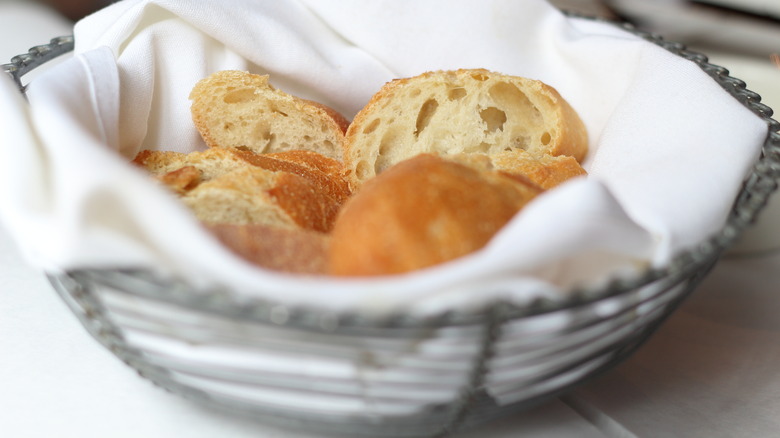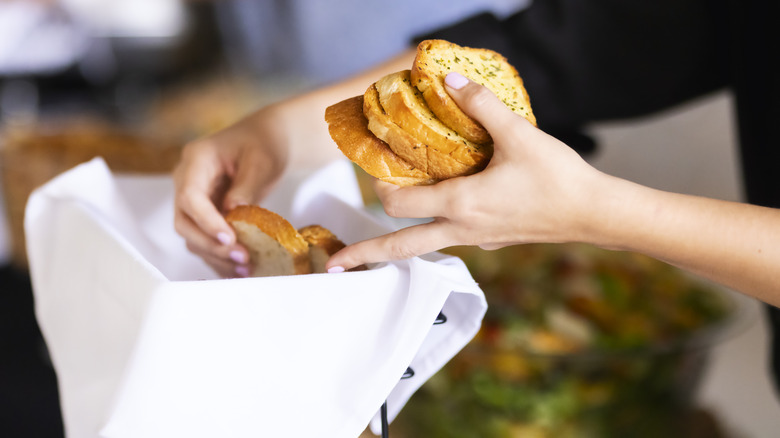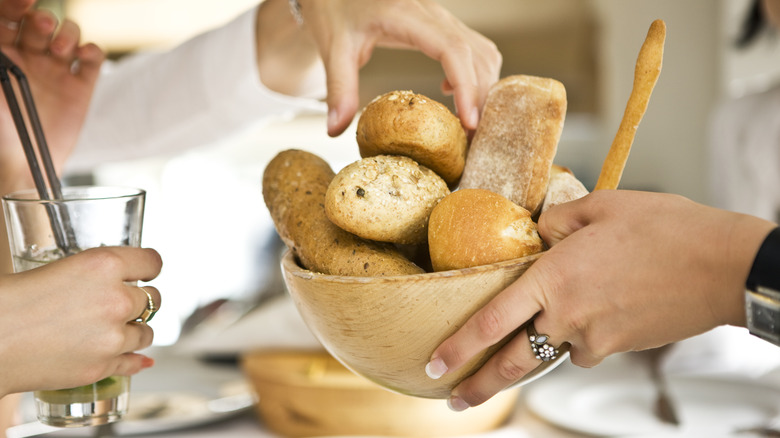The Possible Reasons Restaurants Serve Bread Before The Main Meal
What's the deal with the free bread at restaurants? (Go back and reread that in your best Jerry Seinfeld voice.) The seemingly arbitrary tradition has taken on such a life of its own that different establishments have developed unique spins on the concept, like the crispy seed-covered triangles from Brio or the sweet brown bread from The Cheesecake Factory.
It might just be a way to keep modern foodies from getting "hangry" as they wait for their entrees, thereby increasing overall satisfaction with the dining experience. Folks are less likely to get restless during a busy weekend dinner slot if they're chowing down on some free bread. Maybe it's an exercise in social etiquette. You've eaten a roll only to find that nothing on the menu particularly piques your interest — but your feeling of perceived obligation chains you to the table and stops you from going to another restaurant. Or, maybe you roll up to dinner starving. You want to order a glass of wine, but you're simply too hungry to start drinking on an empty stomach. Don't worry, beckons the free bread basket.
Bread can also function as an accouterment to the meal rather than something to be gorged on beforehand. If you're ordering a saucy pasta or enjoying a soup course, that roll or breadstick can be a crucial vehicle. But, when the bread arrives before the meal, there's a clever reason why.
A sneaky way to stimulate the appetite
Providing free bread before a meal could seem like a counterintuitive practice, considering restaurants would ostensibly want their patrons to order more appetizers and other dishes ... right? Maybe not. Many complimentary bread baskets feature white bread made with unrefined flour, which has the potential to actually increase hunger rather than satiate it.
White bread is a high-glycemic food consisting primarily of carbohydrates (aka sugars), which are easy for the body to quickly break down. These are rapidly digested, causing both a spike in blood sugar levels and a stimulated feeling of hunger. As a semi-viral TikTok by @sweetfiber explains, the free bread basket is actually a low-key way of making guests even hungrier, and there's a strategic reason why it arrives at the same time as your menu. She said, "They know that a glucose spike is going to make you hungrier, crave more, and have a hard time resisting foods. So, while it feels like they're being generous, they are actually winning." That blood sugar spike also tends to crash in time for the dessert course, making you that much more likely to order a treat at the end of your meal.
A tradition steeped in ... tradition
Science aside, the origin and subsequent perpetuation of the free bread basket might also have to do with tradition. According to Anthony Bourdain, some restaurants used to reuse leftover bread baskets for other tables. However, this isn't an official industry practice (not to mention a total FDA food code violation), and it isn't the kind of tradition we're talking about here.
Back in the times of yore, it was customary for taverns to operate simultaneously as bars, restaurants, and lodging houses for wayfaring travelers all under one roof. As such, taverns would provide one meal a day for their guests, and the bread basket was a thrifty way to help guests fill up more quickly. This meant the tavern owners could prepare less of the night's main course to save money and labor. For even earlier foodies, there are multiple biblical mentions of folks serving bread to visiting houseguests, as it was cheap enough to make that even poorer hosts could provide it as a symbol of hospitality. The old saying "breaking bread" exists for a reason, and it refers to sharing a meal with others as a kind of warm, unifying experience. At the end of the day, that complimentary bread basket might just be a symbol of warm welcome even at modern restaurants (if you're optimistic).


